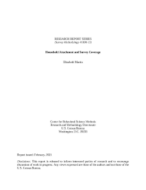Household Attachment and Survey Coverage
Household Attachment and Survey Coverage
Abstract
Errors made by respondents or interviewers in listing persons on household rosters are an important source of coverage errors in censuses and surveys. Withinhousehold omissions account for about one-third of all census omissions, and are higher for males and minorities, and nonrelatives within households (Hogan, 1992; Ellis, 1994; Fay, 1989). Despite the evidence, the household roster has not been approached systematically as a survey measurement problem. Most surveys lack standardized questions and procedures to help interviewers decide whether to list persons whose residence is ambiguous, leaving these determinations to the interviewer's discretion and skill.
Research suggests several reasons why respondents may erroneously omit persons from household rosters. Persons may be concealed due to concerns about how the information is used by Government or others (Hainer et al., 1988; de la Puente, 1993; Tourangeau et al., forthcoming). Complicated living situations, transiency, and tenuous attachments to households make it difficult to determine who should be counted as a household member. Mobility among multiple households contributes to residential ambiguity (Bates and Gerber, 1994). In ambiguous situations, respondents' judgments are influenced by intentions and agreements, financial contributions and permanence of attachment, and other criteria which may conflict with official residency rules (Gerber, 1990; 1994). Arcane terminology and counterintuitive instructions may confuse or mislead respondents (Gerber, 1994; Gerber, Wellens, and Keeley, 1996). Household respondents may lack information about persons in their household, and may assume that part-time residents have a home elsewhere, when they don't. There may be disagreements within households about who belongs there and who doesn't (Hainer, 1987).
Different understandings of roster errors may well imply different strategies for solving them. This paper describes an attempt to improve coverage of tenuously attached persons by expanding the roster questions and probes. The strategy is to cast a broad net in order to identify persons with any attachment to a household, no matter how weak or tenuous. Screening questions are asked to weed out nonresidents, and determine where tenuously attached persons should be counted. This design strategy offers the potential advantage of capturing information about persons in the gray area, who might otherwise be missed entirely, and permits the analyst to evaluate alternative residence criteria and population estimation strategies.
An experimental roster design was implemented in a special pilot survey, the Living Situation Survey. I first briefly describe the survey, then explore two alternative measures of household attachment, and offer some preliminary ideas about how they might be used in developing population estimates.
Others in Series
Working Paper
Working Paper
Working Paper




